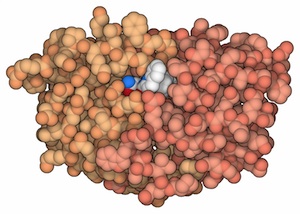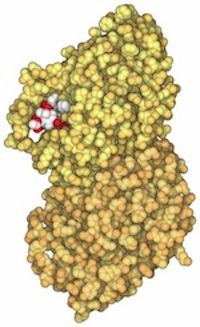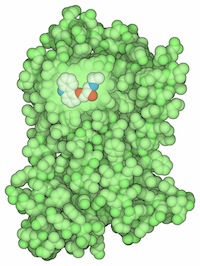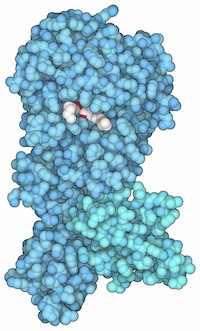Aspirin to Zoloft: Ways Medicines Work

Most medicines work by binding to and modifying the actions of proteins, tiny molecular machines that perform important cellular tasks. Details about protein structure and function help scientists develop medicines that block proteins or otherwise interact with them. But even when a drug is designed to target a specific protein, it can sometimes impact others, causing side effects. The way medicines work also can be influenced by how a person’s body absorbs and processes them.
Findings from research funded by the National Institutes of Health have shed light on how some common medicines work.
Antibiotics, Antivirals
Antibiotics and antiviral drugs attack proteins that are only found in the targeted bacterium or virus and that are crucial for the pathogen’s survival or multiplication. In many cases, the targets are enzymes, which are proteins that speed up chemical reactions. The antibiotic penicillin, for example, hones in on an enzyme that builds bacterial cell walls, causing infecting bacteria to burst and die. Protease inhibitors like saquinavir shut down an enzyme that would otherwise help HIV spread in the body.
Anticancer Agents
Many anticancer drugs act by killing cells that divide rapidly, but they can also affect healthy dividing cells. For example, paclitaxel (Taxol), which is prescribed for breast, ovarian and other cancers, works by binding to the tubulin protein, inhibiting the formation of structures called microtubules that are needed for cell division. Newer anticancer drugs are more discriminating, often targeting important proteins that are abnormally active in certain cancers.One such drug, imatinib mesylate (Gleevec), halts a cell-communication pathway that is always "on" in a cancer of the blood called chronic myelogenous leukemia. Gleevec's target is a protein called a kinase, and the drug’s design is based on years of experiments on the basic biology of how cancer cells grow.
Antihistamines, Antidepressants, Aspirin
Get the world’s most fascinating discoveries delivered straight to your inbox.
Some of the most widely prescribed drugs function by blocking proteins called G protein-coupled receptors, which play key roles in transmitting the signals that allow a cell to respond to its environment. The drug loratadine (Claritin) relieves allergies by blocking the histamine receptor; antidepressant medications (such as Prozac, Paxil and Zoloft) affect the serotonin receptor; and beta-blockers treat heart disease by interfering with the adrenergic receptor. Signaling can also be stopped by targeting the enzymes that create a molecule involved in the process. This is how aspirin works—it inhibits the enzyme cyclooxygenase, which makes pain-signaling molecules called prostaglandins.
Weight Loss, Cholesterol Blockers
Medicines taken to control weight or cholesterol also work by interacting with specific proteins. The weight-loss drug orlistat (Xenical or Alli) blocks the action of pancreatic lipase, reducing the amount of fat that is absorbed from food. Cholesterol-lowering medications, such as atorvastatin (Lipitor) and simvastatin (Zocor), block the action of HMG-CoA reductase, an enzyme involved in making cholesterol.
Future Directions
With a better understanding of the specific relationships between a drug and its target (and off-target) proteins, researchers are using a variety of existing data to identify and test FDA-approved drugs for new uses and to predict potential side effects. This could reduce the time and cost of bringing drugs to market. Scientists are also learning more about how a person’s genes may influence the effectiveness and safety of certain drugs. Another area of active research involves developing new ways to deliver drugs to specific organs or disease sites, also improving therapeutic benefits and reducing side effects.
Content adapted from the poster “How Do Drugs Work?” available from the RCSB Protein Data Bank.
Learn more:
Also in this series:
Exploring the Elusive World of Life’s Most Vital Proteins
5 Ways Computers Boost Drug Discovery
New Uses Proposed for Old Drugs
Studying Protein Shapes Help Combat HIV
This Inside Life Science article was provided to LiveScience in cooperation with the National Institute of General Medical Sciences, part of the National Institutes of Health.






